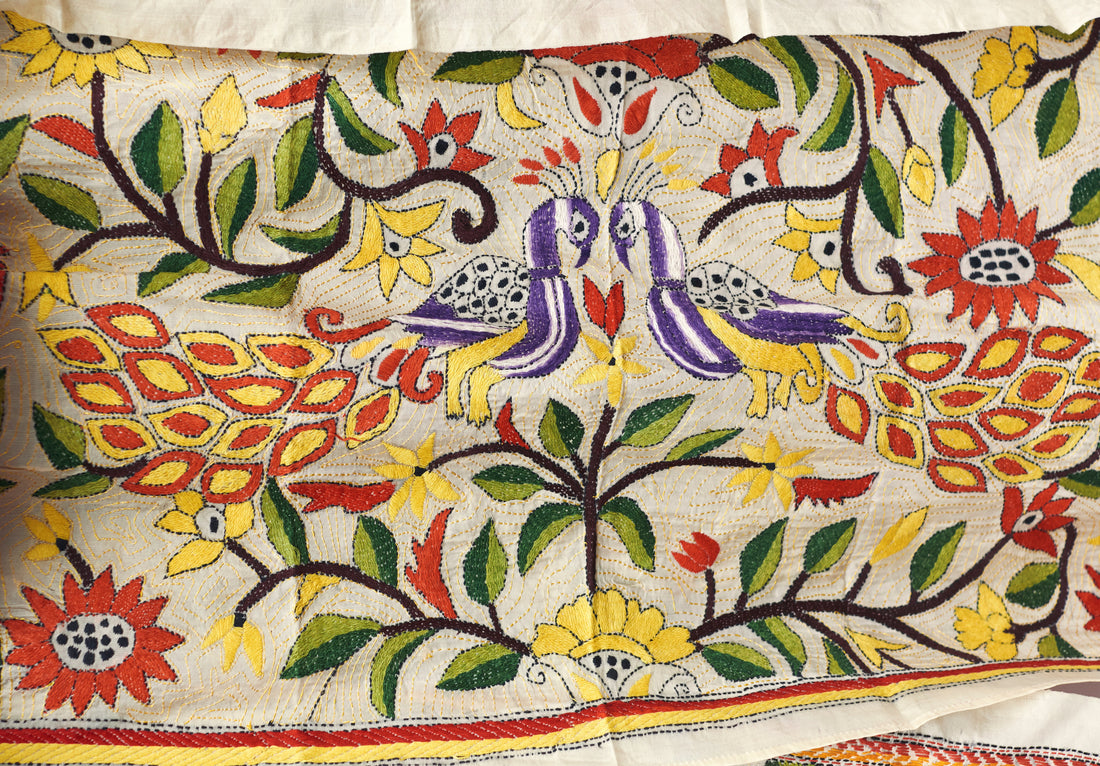
Bengal Kantha Embroidery: A Legacy Sewn into Fabric
Kantha - the pride of Bengal is not just embroidery, it’s storytelling with thread. Rooted deeply in the cultural fabric of West Bengal, Kantha work has been passed down through generations of women who once recycled old sarees and dhotis, stitching them together with simple running stitches to create something profoundly beautiful and emotionally rich.
Today, this centuries-old tradition has taken on new life finding a place not just in households, but on global fashion runways. And at Plumvera, we celebrate the soul of India by bringing these handcrafted Kantha wonders straight to you.
Originating from rural Bengal, Kantha is a form of hand embroidery done using the most basic of stitches – the running stitch. Traditionally, Bengali women would repurpose old fabrics and layer them with delicate rows of stitches to create quilts, throws, and sarees. But Kantha is more than a stitch – it’s an art that weaves personal stories, folklore, nature, and dreams into fabric.
Why Kantha Work is Timeless?
Rooted in Sustainability: Long before eco-conscious fashion became trendy, Kantha celebrated sustainability by breathing new life into worn-out textiles.
Rich with Emotion: Each piece of Kantha carries a narrative – of family, seasons, festivals, or rural life – stitched with care and memory.
Intricate Yet Simple: Despite its minimalistic stitch, Kantha can produce elaborate patterns that elevate any outfit.
Kantha embroidery has grown from rural Bengal homes to become a globally loved textile art. From sarees and dupattas to stoles, bags, and home décor, Kantha finds expression in contemporary designs while retaining its heritage roots. It’s the perfect blend of traditional craft and modern elegance.
At Plumvera, we work directly with women artisans in Bengal, ensuring that each piece is authentic, fair-trade, and filled with heart.
Image Credit:- The Better india
Sada Kantha: It's the most simplest form of stitch and minimal decorative elements are used while creating threadwork.
Image credit:- Pintrest
Sujani Kantha: Popular for quilts and blankets.
Image credit:- Pintrest
Lep Kantha: Heavier, used for winter covers.
Image credit:- Pintrest
Bodhna Kantha: Geometrical and abstract patterns are used in this form of embroidery. Bright-coloured threads, circles, diamonds, and squares are created on fabric.

Stitches
The Kantha stitch is deceptively simple. Just a running stitch but when repeated, it evolves into intricate textures and stories. Each region of Bengal has its own rhythm, patterns, and symbols, passed down like sacred chants through generations of women.
Common Stitch Techniques:
1. Running Stitch
The heart and soul of Kantha embroidery, forming the base of all patterns and motifs.
Image credit:- Pintrest/ Sarah's Hand Embroidery
2. Darning Stitch
Used for bolder lines and dense fills, this stitch creates dramatic visual appeal and texture.

Image credit:- Pintrest
3. Whipped Running Stitch
Known for its raised finish and decorative charm, it adds nuance and depth. Often stitched in bright-colored threads with black outlines, it’s a striking, storytelling stitch used in rural Bengal and Orissa.

Image credit:- Pintrest
Variants of Kantha
Beyond the well-known Nakshi Kantha, there’s Angla Kantha, Durga Kantha, Bajan Kantha, and more — each unique in style and symbolism. These threadwork traditions are not just textile techniques, but family heirlooms of creativity and resilience. What once began as a way to revive old fabrics has now become an artistic revolution — creating fabrics, fashion, and home decor items rooted in sustainable living.
Step-by-Step Process of Bengal Kantha Embroidery:Selecting the Base
The soul of sustainable fashion begins here. Old saris, dhotis, soft cottons, or Tussar silks are chosen for revival. Every piece whispers tales of the past ready to be reimagined.
Planning the Design:
The motifs are hand-sketched using charcoal, chalk, or pencil — often starting from the center or edge and spiraling into rich narratives.
Time for the Running Stitch:
It may seem simple, but in repetition, it becomes divine. Variations like loop and satin stitches add richness to the narrative.
Stitches that Empower
Kantha isn’t just an embroidery technique — it’s a movement. Practiced and perfected by generations of rural women, this art helped them find voice, value, and visibility. These women aren’t just artisans; they are storytellers of survival, weaving beauty out of simplicity.
The first Kantha embroidery factory was set up in Pune in the 1920s.
Nakshi Kantha patterns are visible on both sides of the fabric.
Each motif is a symbol of love, dreams, and spirituality.
Kantha is a women-led revolution, empowering rural women to become self-reliant artisans.
Is Kantha Embroidery Sustainable?
Absolutely. Kantha is the soul of upcycling. Crafted from worn-out textiles and stitched with purpose, it redefines sustainability in fashion.
Farah Khan, Founder of Kantha by Farah Khan
“Hundreds of Kantha artisans were able to sustain their households, hone their skills, and take pride in their craft.”
Neetu, Senior Artisan, Anchal Project
“I know that I will never be able to travel the world, but now my name will!”
Ekta Kaul, Textile Scholar
“A tradition rooted in storytelling and upcycling.”
At Plumvera, we don’t just celebrate Kantha as a textile, we honour it as a symbol of India’s living artistic heritage. We proudly support artisans and showcase authentic Bengal Kantha, helping keep this legacy alive and evolving.
Our Kantha Collection:Every inch is a story, stitched by rural women across Bengal, passed down through generations. For designers who love conscious fashion, Kantha is where heritage meets imagination.
Kantha Sarees
https://www.plumvera.com/products/plumvera-handloom-bengal-kantha-embroidery-banarasi-silk-saree
Future & Survival of the Bengal Kantha Handicraft:Today, Kantha embroidery is thriving in fashion, decor, and global markets. It sustains countless artisans, especially women, in Bengal and nearby regions. Many possess inborn entrepreneurial skills honed over generations.
Frequently Asked Questions:
What is Kantha embroidery?
A traditional running stitch embroidery from Bengal and Orissa, used to repurpose old fabrics into artful quilts and garments. Now a global icon of sustainable fashion.
Which state is famous for it?
West Bengal and Orissa are known for authentic Kantha embroidery.
Traditional materials used?
Old cotton saris, dhotis, bedsheets, Tussar silks, and cotton threads.
Meaning of the word "Kantha"?
Kantha means patched cloth, symbolising repair, care, and transformation.
Primary stitches?
Running stitch, lobe stitch, satin stitch, and Nakshi Kantha embroidery.
Common motifs?
Lotuses, birds, fish, mythological tales, geometric designs.
Products made with Kantha?
Stoles, dupattas, blouses, jackets, cushions, home decor, and more.
How old is this tradition?
Almost 500 years old, a timeless thread in India’s textile heritage.
How is it different from other embroidery styles?
It’s reversible, deeply symbolic, and visually textured unlike most other threadwork.
Is it still practiced today?
Absolutely. And it continues to empower women and support local economies.
Machine-made or handcrafted?
Authentic Bengal Kantha is always hand-stitched. Machines can’t capture its soul.
Regional variations?
Sujani, Bodhana, Lep, and Nakshi Kantha each with its unique stories.
How has it evolved?
From quilts to contemporary couture. It’s now used in jackets, stoles, and beyond.
What is Nakshi Kantha?
An ornate style using floral, animal, and mythic patterns for storytelling.
How are the patterns created?
Designs are hand-sketched, then stitched with layers of threads using running, loop, or satin stitches.

5 comments
skxwq9
skxwq9
t1x7oj
ypx0bm
5e3g7a